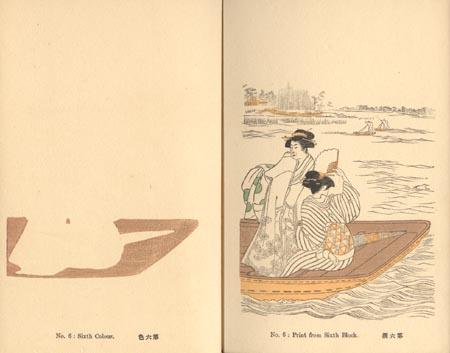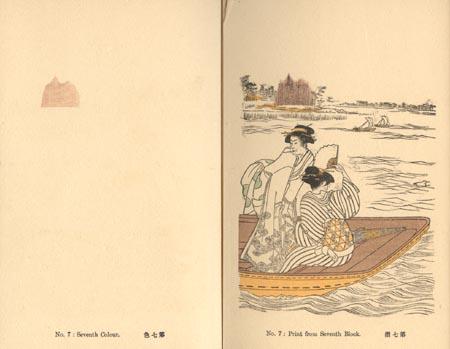|
Condition. The book is in Very Good+ condition. The covering on the spine is complete. The covers have light but uneven toning. There are minor edge tears and scrapes on the covers. The pages are clean and free of faults.
Process of Wood-Cut Printing Explained ("On a Boat by Kiyonaga"), Tokyo, Shimbi Shoin, Ltd, 1938 (2598), 16mo (5 x 7 1/8 in - 12.5 x 18 cm) string tied, stiff wraps with a color woodcut on the front cover, 47 pp (4 page introduction in English, 2 pages of introduction in Japanese, 1 title page, and 40 pages of woodcuts). The woodcut pages were printed on single sheets and then joined along the outside edge with glue. A step by step illustrated guide to how color woodcut prints are made. Using a single print as the basis for the guide, as you go through the book a color woodblock (woodcut) print progresses through it's various manufacturing stages to become a completed image. Each color (even shades of the same color) requires a different block and this is demonstrated step by step. The book contains a 4 page (double folded pages) introduction in english, a 2 page introduction in Japanese (6 numbered pages in total), a title page and the balance consists of 20 woodcuts on the left page and the resulting cumulative state of the woodblock print on the right page. The introduction is printed on thinner paper than the pages with the actual woodblock illustrations. The woodcuts are printed on thick high quality tannish hosho paper.
I have personally examined five versions of this book. The distinctions between them are minor. I call this version type IIIb. For more information on the versions, click here.
The description of the woodcut process is contained in the first four pages of text. Here is how the process is described.
PROCESSES OF WOOD-CUT PRINTING EXPLAINED.
The art of wood-cut printing has been practised in Japan since the eighteenth century, but it made the first really tangible advance with the development of the Ukiyoe school of painters, and during the last few decades has been extensively applied for the reproduction of famous ancient masterpieces. The successive improvements introduced in this essentially Japanese art now place it beyond all possibility of outrivalry by artists of other countries.
The prints made by this process reproduce the slightest touch of the brush and the most delicate shades of colours in the originals, the result being such as can hardly be attained by lithographs. It can be truly said of Oriental paintings that except by this wood-cut process a faithful representation of the originals is impossible. The method of engraving and rubbing demands the utmost skill in the artizans, nor can the difficulties of the modus operandi be adequately measured by the casual observer of the printed picture. We propose, therefore, to give here a brief explanation of the process in the hope of making the real value of Japanese wood-cut printing more widely known.
The blocks are usually made from cherry-wood, but where very fine cutting is needed willow-wood is sometimes used. For each colour and for each shade of the same colour a separate block is provided, and for this reason the number of blocks used for a single picture often reaches several hundreds. A drawing of the ground lines is first made, with outlines of the colour scheme, and from this a block is cut. Having obtained the ground block, a new one for each colour is cut. Since the blocks are liable to swell or shrink with varying atmospheric conditions, it is very important to examine them carefully before going to press, and dry or moisten them as the case may demand. This part of the process requires a great amount of skill in the artizan. Several blocks are sometimes required to print one colour, as it is not always possible to print a whole mass of colour in one shade and at the same time, but a series of blocks has to be employed to produce the desired effect. Laying a single colour on the block in the right manner itself constitutes a difficulty. The usual process of printing begins with the lightest colour and proceeds on to thickest ones, and it varies according to the nature of the colours used in the originals. The rapidity with which colours, sometimes single and sometimes double, dry, must also be taken into consideration, for it is one of the conditions that decide the order or succession of prints. The delicate shading is done with a brush. After the colour has been laid on the block with a brush, the paper is rubbed from the back with an instrument called "baren," made of a piece of ropework covered with a bamboo sheath, which is slightly moistened with oil to make it soft and smooth. A specimen copy of the finished picture is kept before him by the artizan, who is extremely careful to make each copy follow the sample picture in every detail. Only water colours were used till a few years ago, but it has recently been found possible to employ even white lead. Further we have made experiments that have resulted in our being enabled to use vedigris and Prussian blue, and there is now hardly any pigment that cannot be successfully employed in our wood-cut printing.
Every variety of our pictorial art productions can be reproduced by our method of wood-cut printing, which has made a signal developement within the past few decades. The shades produced on our prints are precisely the same as in the originals in tone and materials used, the latter including gold and silver dust, Prussian blue, and verdigris. As a matter of fact our method of reproduction increases the difficulties of the work, but we point with pride to the result, the original pictures reproduced without the slightest deviation in technique or colouring.
The Shimbi Shoin, Ltd.,
Tokyo.
(The Process of Wood-cut Printing Explained, published by the Shimbi Shoin, ca 1920, pages 1-4.)
Title Page
(After Introductions)

Wood-Cut Plates




















Printing Info on Page Following Last Woodcut

Top Line: Tokyo Address
Second Line: Shimbi Shoin
2598 Year (1938)
For more information on Shimbi Shoin and books published by that firm, click here.
|






















